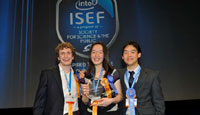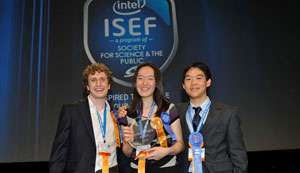 Quantum dots, quantum computing and computing algorithm take top prizes at global high school science competition
Quantum dots, quantum computing and computing algorithm take top prizes at global high school science competition
 Quantum dots, quantum computing and computing algorithm take top prizes at global high school science competition
Quantum dots, quantum computing and computing algorithm take top prizes at global high school science competition
At the conclusion of the weeklong high school science competition, projects on cancer-fighting quantum dots, quantum computer algorithms and computer programming claimed the highest honors. In all, nearly a third of the entered projects were honored during the May 14 ceremony at the 2010 Intel ISEF, a program of Society for Science & the Public. Winners received cash awards ranging from $500 to the top prize of $75,000; other prizes ranged from field trips to officially naming an asteroid for the recipient.
The annual event attracts some of the world’s best and brightest young scientists, representing more than 50 nations. The 1,611 students who attended this year also won the respect and admiration of Nobel laureates, scientific judges and the general public.
“As a group, you are a force for profound good,” Elizabeth Marincola told the finalists. President of the Society for Science & the Public and publisher of Science News, Marincola pointed out that although some students left without prizes, “your passion, competence and dedication make you all winners.”
This year’s new top prize, the $75,000 Gordon E. Moore award, went to Amy Cindy Chyao of
Through a series of chemical reactions, Chyao attached quantum dots to titanium dioxide nanotubes (the dots are akin to tiny ants on a nanotube log about 10,000 times the size of a human hair). On their own, the nanotubes can produce a toxic, unstable form of oxygen when hit with high-energy light, such as UV rays. Since cancer cells tend to slurp up more nanoparticles than do noncancerous cells, the malignancy is targeted by the cell-killing toxicity. But UV light itself can cause the kind of damage that leads to cancer.
In a quest for a safer alternative, Chyao affixed lead sulfide quantum dots to the nanotubes, which changed the type of light required to activate them. She showed that less damaging near-infrared light could be used to produce the toxic oxygen. When Chyao saw the results of the assay confirming that her design worked, “I was extremely excited,” she says.
The top prize winner’s project almost didn’t make it to the fair. Chyao put the finishing touches on her study three days before the fair started, she says. In the melee of packing and leaving for the airport, her poster was left at home. Her father — in an act of parental heroism not soon to be forgotten — drove the hour back to the house and dashed back to the airport just in time to catch the flight to
Chyao will be doing a summer internship at the
Yale Wang Fan of
Fan got interested in quantum mechanics in eighth grade, and began reading books and research papers before he developed his own projects.
Kevin Michael Ellis of
With today’s technology, individual microprocessors can’t be made to go faster, “or they’d melt,” Ellis says. So instead, most computers have two to four microprocessors. But divvying up the tasks among microprocessors must still be programmed by hand. “My tool automates that process,” he says.
Ellis created a program called Dyn that automatically decides what to split up and how to do it. Unlike other parallelism techniques, Dyn requires no manual work, and its performance doesn’t suffer as the task size increases. Ellis put Dyn through its paces on intense applications such as physics simulations, 3-D computations and artificial intelligence problems. He then compared its performance to what a human programmer could do by hand. Dyn performed almost as well as a human programmer, he found.
Three other students won Seaborg SIYSS Awards, named for the late chemist Glenn T. Seaborg, a Nobel laureate who chaired the board of Society for Science & the Public. Seaborg SIYSS Awards come with a paid trip to the Stockholm International Youth Science Seminar in
James Sinclair Popper of
Seaborg Prize winner Joshua William Pfeffer of
The third Seaborg prize went to Jong Hyuck Won of
Akash Krishnan and Matthew Fernandez, both of
In all, Intel ISEF Best of Category awards went to 19 categories, and winners also received an $8,000 prize. All winners of the top prizes also won in their categories. Second- and first-place category winners, who took home $1,500 and $3,000 respectively, also got the bonus of having an asteroid named in their honor, a gift from MIT’s Lincoln Laboratory. (MIT’s Jenifer Brinker Evans stipulated that the asteroids would be far away in the main asteroid belt, so the winners didn’t need to worry about having their namesake destroy the Earth.) In all, 602 students took home prizes.
For many students, the awards represented the culmination of many hours of hard work. “It’s been a very exciting day,” said Ellis, just after he won Intel’s Young Scientist Award. Ellis had these words of advice for younger scientists: “Do what they really love. I would advise them to do things not because other people want them to, but because they think the end result would be really, really cool.”

 Previous page
Previous page Back to top
Back to top







